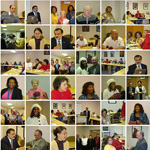Friday, January 30, 2009
American Educational Studies Association (AESA) Conference
AESA was established in 1968 as an international society for students, teachers, research scholars, and administrators who are interested in the foundations of education. As such, the workshops covered a large amount of area including ethics, the globalization of education, addressing hegemonic systems within institutions of education, activism, and queer theory. I attended several workshops, mostly set up as panels discussions, that really enlightened my worldview as a teacher and provided me with more passion and energy to share with my students.
One of the keynote addresses was done by Gloria Ladson Billings, and she discussed educating students in a post-Brown era. This was one of the most riveting addresses I have been to, as she shared insights on how to creat passion and enthusiasm about social justice and education in an era that sometimes believes that racism is over. I had the opportunity to take a photo and chat with Dr. Ladson Billings and my time spent with her reminds me why I choose higher education as my profession.
I learned a lot from my brief time with the AESA group, and I highly recommed this conference for those interested in social justice. I am looking foward to attending next year's conference in Pittsburgh, PA.
Thursday, January 29, 2009
2008 AACE eLearn Conference, Las Vegas
2)Use of Technology as Faculty Assessment focused on video taping teaching sessions, self critique, peer-review, and administrator assessment of teaching performance. The idea of the professor, a peer, and administrator integrating feedback for the teaching professor was novel. I could see that the narratives gathered from each source would be very helpful for refining, exploring, and acquiring new teaching skills. Also emphasized was the reflective part of the assessment. Using the video, the instructor could review for behavioral patterns that either enhanced learning or impeded it. The video could also serve as a baseline to be compared to a future recording delivering the same lesson using more effective strategies and teaching techniques. The whole university system would benefit from the exposure of the session's content.
Wednesday, January 7, 2009
CLA conference Iessons learned
One session particularly attracted my attention. It focused on:
THE WEST AFRICAN INFLUENCE ON LIFE , LANGUAGE, AND CULTURE OF THE NATIVES OF THE SOUTH CAROLINA LOW COUNTRY AND NEIGHBORING SEA ISLANDS (HISTORICAL ORIGINS OF THE GULLAH-GEECHEE IN THE USA).
The following is a synopsis of this interesting session.
The Gullah-Geechee can be considered as a group of Black people or a language. Both of them have strong African roots predominantly found in West and Central Africa. Because of the geographical isolations of the barrier Sea Islands, the Gullah people have been able to retain much of their African culture, Creole language, spiritual beliefs, ontology and cosmogony.
THE GULLAH -GEECHEE AS A GROUP OF BLACK PEOPLE
The Gullah are Blacks who live in the Low Country of South Carolina and Georgia, that is: the coastal plain and the Sea Islands. Historically, the Gullah area once extended from the North to the Cape Fear area on the coast of North Carolina and the south to the vicinity of Jacksonville on the coast of Florida. However, today, the Gullah area is confined to South Carolina and Georgia Low Country. The Gullah, as a Black community, distinguish themselves in terms of preserving more of their African linguistic and cultural heritage than any other Black community living in the United States. The first majority of Gullah's ancestors were brought to South Carolina, and Georgia Low Country through the ports of Charleston and Savannah as slaves circa the seventeen-century. They were from West Africa and especially from countries that are currently called: Senegal, Gambia, Mali, Guinea,Liberia, Sierra Leone, Guinea-Bissau, and Ghana. The second majority of Gullah's ancestors were brought from modern Angola, Congo and West Indies. They were very good African farmers and especially excelled in the art of cultivating rice. Accordingly, they brought the skills that made rice one of the most successful industries in early America. For instance, South Carolina and Georgia were covered by a cornucopia of acres of magnificent rice fields. The Gullahs were also cultivating the "gumbo", that is: "okra". The word "gumbo" stems from the Umbundu language of Angola meaning "okra". It is noteworthy that African influences are found in every aspect of the Gullahs' traditional life style and predominantly in agriculture and cooking. Gullah rice dishes called "red rice" and "okra" soup are similar to West African "ouolof rice" and "okra soup". Actually, Ouolof rice was brought by the Ouolof and the Malinke peoples (Mande) from West Africa. African influences are also linguistic.
THE GULLAH-GEECHEE AS A LANGUAGE ENDOWED WITH AFRICAN ROOTS
I was amazed to find words very similar (morphologically and lexically) to those of my own language Fang-Beti which is spoken in modern Cameroon.
Therefore, through this session, I realized the important African, historical, and cultural legacy found through the Gullah-Geechee. The Gullah-Geechee has proven to be a powerful linguistic and cultural tool. Researchers, politicians, and decision makers should endeavor to preserve this powerful language and the culture subsuming it. It does subsume special connections between African and the USA. Nowadays, most social groups that had lost their roots are interested in decrypting them to assert themselves. It follows that revisiting the Gullah-Geechee legacy can prove to be a significant step towards such a heuristic undertaking. A number of Gullah scholars have worked in this direction by writing insightful books. Let us mention but a few:
-Creel, Margaret Washington. "A peculiar People: Slave Religion and Community Culture among the Gullahs", New york: New York University Press, 1988.
-Joyner, Charles. "Down by the Riverside: A South Carolina Slave Community", Urbana: University of Illinois Press, 1984.
-Kiser, Clyde Vernon "Sea Island to City: A Study of St Helena Islanders in Harlem and Other Urban Centers", New York: Atheneum, 1969.
